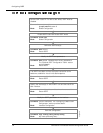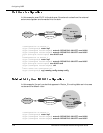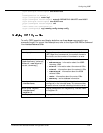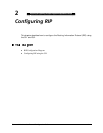
Configuring OSPF
1-8 Command Line Interface Protocol Configuration Guide
Table 1-2. Tasks and Commands to Configure Additional OSPF Parameters
Router:OSPF Mode
Define an OSPF area to be a stub
area or a NSSA. Add the command
to all routers within the area. The
no form of a command removes a
stub area or NSSA.
The "OSPF Configuration
Examples" section includes stub
area and NSSA configurations.
The no form removes a stub area or
NSSA definition.
area area-id stub
no area area-id stub
area area-id nssa
no area area-id nssa
area-id - identifier for the
stub/NSSA. This is a decimal
value or an IP address.
(For ABRs only) The cost of the
default route injected in the stub or
NSSA. The default cost is 1.
The no form restores the default.
area area-id
default-cost cost
no area area-id
default-cost
area-id - identifier for the
stub/NSSA. This is a decimal
value or an IP address.
cost - a 24-bit number that
represents the cost for the default
summary route within the stub
or NSSA.
Configure route summarization on
the ABR to consolidate and
summarize routes at an area
boundary. This causes a single
summary route to be advertised to
other areas. Route summarization
minimizes the number of routing
table entries and localizes the
impact of a topology change.
The no form disables route
summarization.
area area-id range
ip-address mask
[no-advertise]
no area area-id range
area-id - identifier of the area
about which routes are to be
summarized.
ip-address - IP address of the
network to be advertised.
mask - IP subnet mask of the
network to be advertised.
no-advertise - suppresses
advertisements of IP routes.
Configure the link-state
advertisements (LSAs).
The no form removes an LSA
definition.
area area-id ase-filter
no area area-id ase-filter
area area-id
translate-nssa-to-
external
no area area-id
translate-nssa-to-
external
Filter type 3 ASE LSAs.
Translate type 7 LSAs into type 5.


















